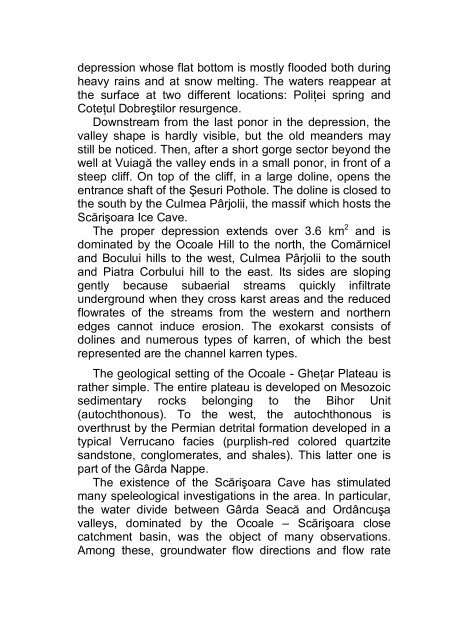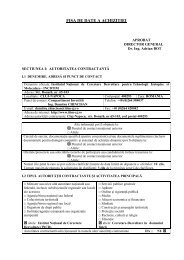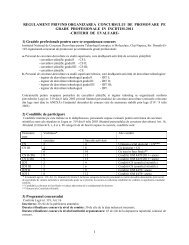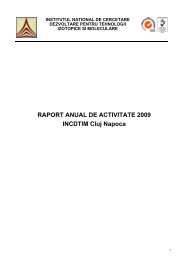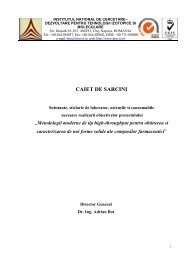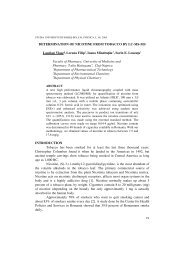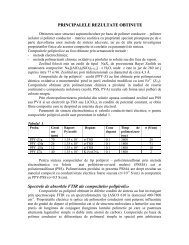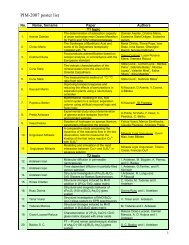Karst and caves in the Bihor Mountains - ITIM
Karst and caves in the Bihor Mountains - ITIM
Karst and caves in the Bihor Mountains - ITIM
- No tags were found...
You also want an ePaper? Increase the reach of your titles
YUMPU automatically turns print PDFs into web optimized ePapers that Google loves.
depression whose flat bottom is mostly flooded both dur<strong>in</strong>gheavy ra<strong>in</strong>s <strong>and</strong> at snow melt<strong>in</strong>g. The waters reappear at<strong>the</strong> surface at two different locations: Poliţei spr<strong>in</strong>g <strong>and</strong>Coteţul Dobreştilor resurgence.Downstream from <strong>the</strong> last ponor <strong>in</strong> <strong>the</strong> depression, <strong>the</strong>valley shape is hardly visible, but <strong>the</strong> old me<strong>and</strong>ers maystill be noticed. Then, after a short gorge sector beyond <strong>the</strong>well at Vuiagă <strong>the</strong> valley ends <strong>in</strong> a small ponor, <strong>in</strong> front of asteep cliff. On top of <strong>the</strong> cliff, <strong>in</strong> a large dol<strong>in</strong>e, opens <strong>the</strong>entrance shaft of <strong>the</strong> Şesuri Pothole. The dol<strong>in</strong>e is closed to<strong>the</strong> south by <strong>the</strong> Culmea Pârjolii, <strong>the</strong> massif which hosts <strong>the</strong>Scărişoara Ice Cave.The proper depression extends over 3.6 km 2 <strong>and</strong> isdom<strong>in</strong>ated by <strong>the</strong> Ocoale Hill to <strong>the</strong> north, <strong>the</strong> Comărnicel<strong>and</strong> Bocului hills to <strong>the</strong> west, Culmea Pârjolii to <strong>the</strong> south<strong>and</strong> Piatra Corbului hill to <strong>the</strong> east. Its sides are slop<strong>in</strong>ggently because subaerial streams quickly <strong>in</strong>filtrateunderground when <strong>the</strong>y cross karst areas <strong>and</strong> <strong>the</strong> reducedflowrates of <strong>the</strong> streams from <strong>the</strong> western <strong>and</strong> nor<strong>the</strong>rnedges cannot <strong>in</strong>duce erosion. The exokarst consists ofdol<strong>in</strong>es <strong>and</strong> numerous types of karren, of which <strong>the</strong> bestrepresented are <strong>the</strong> channel karren types.The geological sett<strong>in</strong>g of <strong>the</strong> Ocoale - Gheţar Plateau isra<strong>the</strong>r simple. The entire plateau is developed on Mesozoicsedimentary rocks belong<strong>in</strong>g to <strong>the</strong> <strong>Bihor</strong> Unit(autochthonous). To <strong>the</strong> west, <strong>the</strong> autochthonous isoverthrust by <strong>the</strong> Permian detrital formation developed <strong>in</strong> atypical Verrucano facies (purplish-red colored quartzites<strong>and</strong>stone, conglomerates, <strong>and</strong> shales). This latter one ispart of <strong>the</strong> Gârda Nappe.The existence of <strong>the</strong> Scărişoara Cave has stimulatedmany speleological <strong>in</strong>vestigations <strong>in</strong> <strong>the</strong> area. In particular,<strong>the</strong> water divide between Gârda Seacă <strong>and</strong> Ordâncuşavalleys, dom<strong>in</strong>ated by <strong>the</strong> Ocoale – Scărişoara closecatchment bas<strong>in</strong>, was <strong>the</strong> object of many observations.Among <strong>the</strong>se, groundwater flow directions <strong>and</strong> flow rate


